

Table of contents
- General information
- symptoms
- chemical sprays
- Biological sprays
- yellow boards
- network coverage
- ground cover
- prevention
- Avoidance through variety selection
An infestation of the native cherry trees with cherry fruit flies can develop into a real plague and make the cherry harvest completely inedible. In order to protect the delicious fruit from the voracious maggots of the flies, a mixture of different defense methods is necessary in most cases. These countermeasures concern both the spiked means and the precaution and the selection of a more resistant variety.
General information
The cherry fruit fly is a dreaded pest that reproduces with the help of cherries. At the end of spring, the fly specifically seeks out cherry trees in order to feed on the fruit and lay their eggs there. Especially when the sun is shining, the cherry fruit flies suck the food and host plant to prepare for reproduction. The larvae that then hatch often eat their way through to the cherry stone and destroy the entire fruit. After laying the eggs and developing the larvae, the cherries begin to rot and then fall to the ground. Late-ripening varieties are particularly affected, as the flies do not reproduce until the beginning of summer. Especially in very dry years with warm temperatures and little rainfall, this pest can develop into an extreme plague.
- Prefers sour cherries, snowberries, bird cherries and bird cherries
- Cherry fruit fly grows between 3.5-5 mm
- Hatches from pupae in the ground in spring
- Flight time is between mid-May and early July
- Feeds on the nectar of cherries for about 10 days
- Up to 200 eggs are then laid
- Lay eggs only in yellow to light red fruits
- The maggots hatch after 5-12 days
- Leave the fruit after approx. 3 to 4 weeks
symptoms
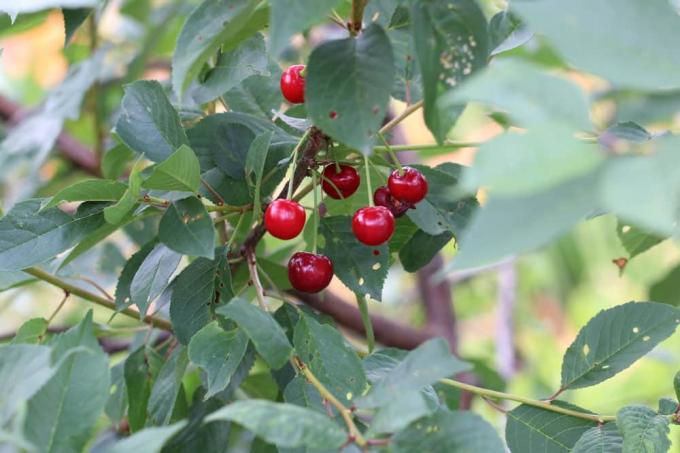
The cherry fruit fly has the botanical name Rhagoletis cerasi and is distributed in both Europe and Asia. It has certain similarities to the traditional housefly, but if you take a closer look, you can quickly spot the differences. Due to the characteristic external features, the pest can be recognized quite well in the garden. If the flies are present in large numbers, then they are either approaching or an infestation has already occurred. Affected fruits only change after some time, so the cherry trees should always be observed and the fruits should be checked regularly for changes. Only in this way can appropriate countermeasures be taken in good time to prevent the spread of a plague and save the rest of the harvest.
- Bow tie is characterized by wings with brownish bands in a transverse shape
- Green compound eyes are characteristic
- Forms trapezoidal and yellow carapace, which is extremely conspicuous
- Infestation shows up in the stem area by brownish discolored areas
- Flesh softens around the core and begins to rot
- Inside the fruit are one or more maggots
- Maggots are white and grow up to 6 mm long
- Usually stay near the core
- When tearing open the fruit, maggots are clearly visible
- Flies can lay up to 80 eggs in a single fruit
- A single fly can infest more than a kilogram of cherries
chemical sprays
Most chemical agents against the cherry fruit fly are no longer permitted in Germany. However, there are still a few remedies that are not allowed in home gardens.
- Mospilan SG can only be used for professional fruit growing
- May only be used by competent persons
- Chemical agent is not approved for home and small garden use
Biological sprays
For private use there are biological sprays against the cherry fruit fly, which can be bought in specialist shops and on the Internet. The main antagonists of the cherry fruit fly are fungi, which attack the insects and thus render them harmless. These are biodegradable and harmless to humans. However, the fungal spores are inactivated relatively quickly by the UV rays, which is why the treatment has to be carried out several times. In this way, flies that hatch later are also destroyed.
- Use fungus-based pesticides
- The fungus Beauveria bassiana has proven itself
- Multiple treatments are necessary to achieve high efficiency
- Carry out the first treatment about a week after the start of the flight
- Sufficient application on well-cut trees is important
- Complete wetting of the entire canopy is required
- Repeat every week until a few days before harvest
yellow boards
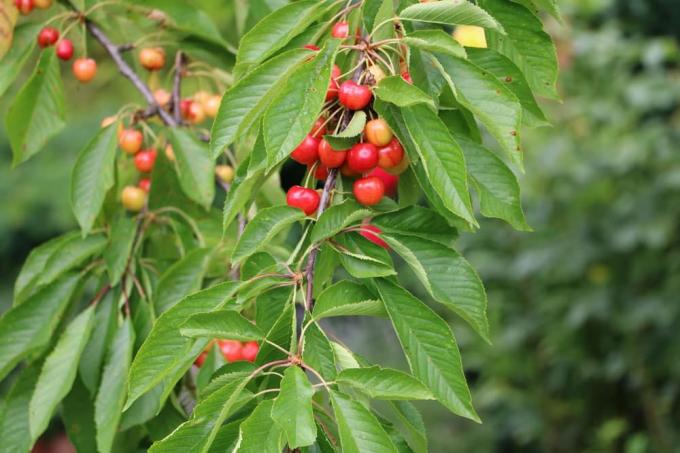
At the storage time, the cherry fruits are still yellow and are just ripening, which is why the cherry fruit flies are fixated on their yellow coloration. Yellow boards are a biological control measure against the cherry fruit fly and are suitable for catching the pests. These attract the flies when the fruit begins to turn yellow and keep them away from the cherries. However, the yellow glue boards must be installed in sufficient quantities at the start of the flight, otherwise an infestation may already have occurred. Since a single fly can lay up to 200 eggs, this method is very useful to protect the cherries. However, the panels should only be used from the start of flight to the end of harvest, as they also attract and perish other, often beneficial, insects.
- Install 2-10 panels depending on tree size
- Use at least two traps per meter of tree height
- Attach to the southern and western sides of the tree
- Ideally install outside of the crown
- Flies are attracted by the yellow color
- Stick to the glued surface
- Method catches a large part of the flies
- In this way, oviposition is prevented in the long term
Tip:
If you want to increase the effect of the yellow boards, you can add an attractant to the traps. These pheromone traps are also available fully equipped from specialist retailers.
network coverage
A holistic measure against an infestation with cherry fruit flies is the protection of the fruit with the help of a net. However, this method is somewhat difficult with old trees. If the trees are taller than a house and have developed extremely expansive branches, then it is a difficult undertaking to encircle the entire treetop with a net and close it protection. When buying the nets, it is essential to pay attention to the correct dimensions for the meshes. If the holes in the net are too big, the cherry fruit flies can easily slip through the mesh and still lay their eggs in the cherries. In addition, the nets also provide good protection against other pests and voracious birds.
Tip:
Nets are ideal for smaller trees.
- Also useful for sections of the cherry tree
- In the case of very large trees, only protect areas with many fruits
- Close-meshed nets are available in hardware stores and garden centers
- Stitches must not be too wide
- Mesh size should be between 0.8-1.2 mm
ground cover
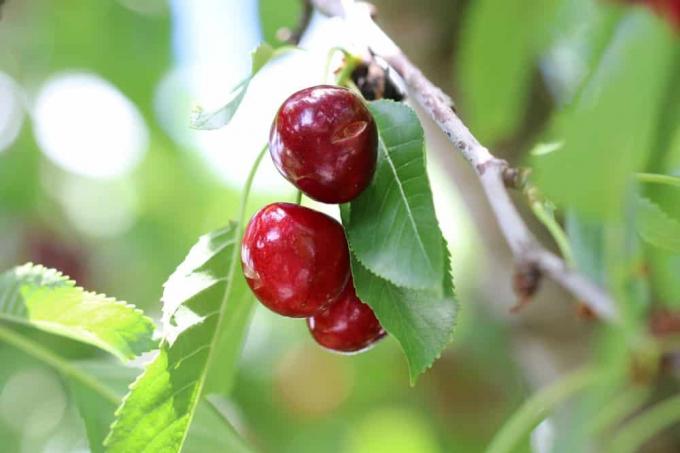
The cherry fruit flies hatch from the pupae in mid-May, which are buried in the ground at a depth of approx. 3 cm have overwintered. This time depends on the weather and can therefore differ from year to year. If the ground is covered, the hatching of adult flies from the ground can be temporarily suppressed. Furthermore, a soil cover can prevent the maggots from digging into the soil from the outset. The maggots either drop to the ground from the eaten cherries or fall down from the tree along with the rotten cherries. The maggots then crawl into the ground. If this contact with soil is broken, then no new cherry fruit flies hatch by the next end of spring.
- Cover the ground with netting before hatching
- Dig the net edges deeper to guarantee a firm hold
- Flies remain trapped under the net until harvest
- Necessary mesh size 0.8-1.2 mm
- Lay out tarpaulin or fleece on the ground under the cherry tree
- All falling cherries and maggots land on a laid out surface
- Afterwards, sweep up and collect what has fallen down every day
- Put maggots and fallen fruit in transparent and tightly sealable garbage bags
- Leave the bag in full sun
- All the maggots die off due to the resulting heat
- Dispose of the contents of the bag in the compost after a few days
prevention
Certain precautionary measures can be taken to ensure that neither the cherry fruit fly nor its maggots can spread. In addition, wild cherries and honeysuckles should not grow near cultivated cherries intended for harvest, as these increase the risk of transmission. Certain bird species that hunt insects as prey in flight can significantly deplete the number of adult cherry fruit flies. In addition, nematodes can also be used to achieve good control efficiency. The parasitic roundworms penetrate the larvae through the skin and kill them while they are still in the soil.
- Keeping poultry in the garden reduces infestation
- Chickens pick up fallen maggots and hatching pupae from the ground
- Provide nesting sites for swifts and swallows
- Natural predators are also ground beetles, parasitic wasps and spiders
- Mow very late under the cherry tree so that the ground stays cool longer
- This delays the hatching of the flies
- Introduce nematodes of the genus Steinernema in early June
- Fill the watering can with warm and stale tap water and the nematodes
- Immediately apply these under the infested trees
Avoidance through variety selection
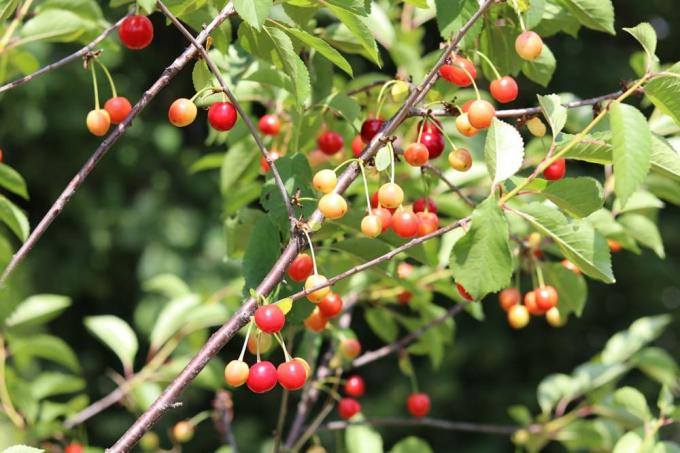
In order to prevent an infestation from the start, the right choice of variety is crucial. If the cherry tree bears fruit very early in the year, the yellowing of the fruit will occur at a time when the cherry fruit flies have not yet pupated.
- Late-ripening varieties are particularly affected
- Early maturing varieties are usually much less affected
- Early varieties include Burlat, Earlise and Lapins, among others
- Yellow-fruited varieties are also less susceptible, e.g. B. Dönissen's Yellow
 garden editorial
garden editorial I write about everything that interests me in my garden.
Learn more about crop protection products

Fight powdery mildew successfully | 12 remedies against powdery mildew
If the hobby gardener hears the word "mildew" the alarm bells are already ringing. Because these fungi can cause enormous damage to ornamental and useful plants. Once the plant has been infected, combating the fungus is the top priority. Here you can find out which means will help you in the fight against the whitish to greyish plaque.

Natural sprays for fruit trees - when and with what to spray
Fruit trees in particular are often attacked by one or the other pest, so that the harvest fails less in summer. Since the fruit should grow as naturally as possible and should therefore be suitable for consumption, only natural pesticides should be used.

Combat pear rust: Sprays and home remedies for pear rust
pear grating. Even the name is a nightmare for owners of pear trees, because this stubborn fungal disease can weaken pears over the years and does not decrease in intensity. Nevertheless, there are some ways and means to prevent the infestation.

Sprays in viticulture
Sprays in viticulture are hardly ever used. The weed killers are pesticides and herbicides or synthetic fertilizers are used.
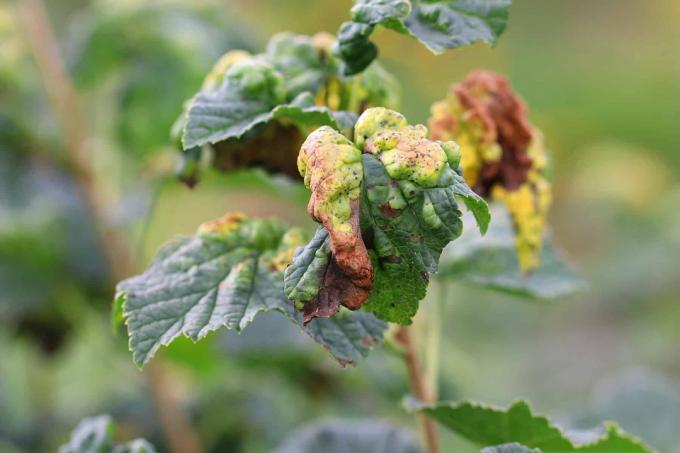
Leaf diseases on currants: leaf fall disease & Co
Diseases on the leaves are not uncommon in currants. They are triggered by fungi, viruses or various pests settle in. Many problems can be remedied with simple home remedies. Proper care also helps to prevent many diseases.
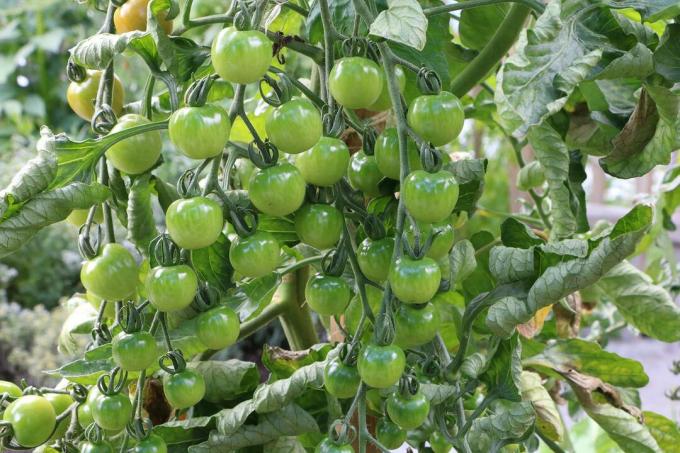
Fertilize tomatoes: how often, when and with what?
Tomatoes need a consistently high amount of nutrients for the development of flowers and fruits. In addition to choosing the right fertilizer, the amount and frequency also play an important role. All essential information for an optimal dosage can be found here.



